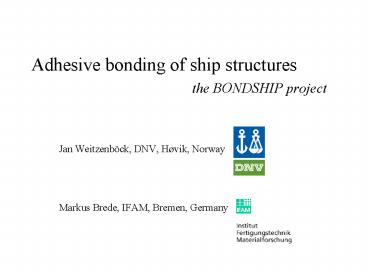Adhesive bonding of ship structures the BONDSHIP project
1 / 16
Title:
Adhesive bonding of ship structures the BONDSHIP project
Description:
'Bonding of lightweight materials for cost effective ... Example: Sandwich plate. Applied load: 100kN. Failure criteria: Shear stress Txy along red line ... –
Number of Views:196
Avg rating:3.0/5.0
Title: Adhesive bonding of ship structures the BONDSHIP project
1
Adhesive bonding of ship structures
the BONDSHIP project
- Jan Weitzenböck, DNV, Høvik, Norway
- Markus Brede, IFAM, Bremen, Germany
2
Outline
- BONDSHIP project
- Modelling of joints
- Some benchmark results
- New failure criterion
- Approval of joints
3
BONDSHIP -
- Bonding of lightweight materials for cost
effective production of high speed craft and
passenger ships
4
The partners
5
The BONDSHIP guidelines
6
Modelling rigid adhesives
Predicted yield point and experimental results
Calculated failure load and experimental results
7
Failure criterion (i)
Shear stress and peel stress at exp. lap shear
strength according to linear FEA
Failure criteria with linear analysis has to be
developed with experiments.
at 38.4 MPa
8
Failure criterion (ii)
Failure criteria with linear analysis has to be
developed from experiments
Average stress along red line
ta/10
ta
ta
Failure criteria Average shear stress Txy
along red line exceeds 57.5 MPa and/or peel
stress Sy exceeds 85 MPa .
ta thickness of adhesive layer
9
Example Sandwich plate
10
Applied load 100kN
11
- Failure criteria
- Shear stress Txy along red line
- exceeds 57.5 MPa and/or peel
- stress Sy ? S1 exceeds 85 MPa
- Failure at about 100 kN.
12
Experimental results
Exp. strength 105 ? 39 kN
13
Approval of joints why new approach?
- The use of bonded joints faces one major
obstacle the lack of knowledge about the
long-term performance - The prediction of long-term performance of a
bonded joint is usually done with accelerated
ageing tests. - Test results are confirmed by in-service data
obtained from typical ship environments - This represents a classic chicken-and-egg
problem - the long-term performance of bonded joints in a
marine environment must be documented by relevant
in-service experience. - However, it will not be possible to gain this
experience without practical application on ships
or other marine structures.
14
Approval of joints traditional approach
- In traditional ship structure design for large
SOLAS type ships different grades of steel are
being used. - Welding is the dominating joining method.
- A significant body of information and experience
exists for the design and production of welded
steel structures. - Joint geometries have been standardised,
designers have a thorough understanding of good
joint design and how to design for long-term
loading - On this basis designers can design structures
that meet with confidence the lifetimes
stipulated by ship owners and operators (in most
cases).
15
Outline of new approach to joint approval
- Use formal hazard identification to identify
possible causes and consequences of long-term
degradation and possible consequential damage.
Review the identified hazards and if necessary
take measures to control the associated risks. - Use best practice in material selection, joint
design and production technology. - It should be possible to detect failure early
enough. Furthermore the joint has to be designed
with sufficient redundancy and reserve strength
to ensure that detectable damage is tolerable. - Develop and demonstrate a repair procedure for
the joints to be able to repair any damage that
may occur.
16
More information about BONDSHIP
- http//research.dnv.com/bondship
- (www.bondship.com)































